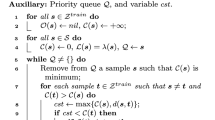Abstract
We have shown a supervised approach for pattern classification, which interprets the training samples as nodes of a complete arc-weighted graph and computes an optimum-path forest rooted at some of the closest samples between distinct classes. A new sample is classified by the label of the root which offers to it the optimum path. We propose a variant, in which the training samples are the nodes of a graph, whose the arcs are the k-nearest neighbors in the feature space. The graph is weighted on the nodes by their probability density values (pdf) and the optimum-path forest is rooted at the maxima of the pdf. The best value of k is computed by the maximum accuracy of classification in the training set. A test sample is assigned to the class of the maximum, which offers to it the optimum path. Preliminary results have shown that the proposed approach can outperform the previous one and the SVM classifier in some datasets.
Preview
Unable to display preview. Download preview PDF.
Similar content being viewed by others
References
Haykin, S.: Neural networks: A comprehensive foundation. Prentice-Hall, Englewood Cliffs (1994)
Reynolds, D., Rose, R.: Robust text-independent speaker identification using gaussian mixture speaker models. IEEE Transactions on Speech and Audio Processing 3, 72–83 (1995)
Boser, B., Guyon, I., Vapnik, V.: A training algorithm for optimal margin classifiers. In: 5th Workshop on Computational Learning Theory, pp. 144–152. ACM Press, New York (1992)
Fukunaga, K., Narendra, P.M.: A branch and bound algorithms for computing k-nearest neighbors. IEEE Transactions on Computers 24, 750–753 (1975)
Papa, J., Falcão, A., Miranda, P., Suzuki, C., Mascarenhas, N.: Design of robust pattern classifiers based on pptimum-path forests. In: Mathematical Morphology and its Applications to Signal and Image Processing (ISMM), MCT/INPE, pp. 337–348 (2007)
Papa, J., Falcão, A., Suzuki, C., Mascarenhas, N.: A discrete approach for supervised pattern recognition. In: Brimkov, V.E., Barneva, R.P., Hauptman, H.A. (eds.) IWCIA 2008. LNCS, vol. 4958, pp. 136–147. Springer, Heidelberg (2008)
Rocha, L.M., Falcão, A.X., Meloni, L.G.P.: A robust extension of the mean shift algorithm using optimum path forest. In: 8th Intl. Workshop on Combinatorial Image Analysis, Buffalo-NY, USA, RPS, pp. 29–38 (2008) ISBN 978-981-08-0228-8
Cappabianco, F., Falcão, A., Rocha, L.: Clustering by optimum path forest and its application to automatic GM/WM classification in MR-T1 images of the brain. In: The Fifth IEEE Intl. Symp. on Biomedical Imaging (ISBI), Paris, France (accepted, 2008)
Kuncheva, L.I.: Combining Pattern Classifiers: Methods and Algorithms. Wiley Interscience, Hoboken (2004)
Reyzin, L., Schapire, R.E.: How boosting the margin can also boost classifier complexity. In: 23th Intl. Conf. on Machine learning, pp. 753–760. ACM Press, New York (2006)
Duan, K., Keerthi, S.S.: Which is the best multiclass svm method? an empirical study. Multiple Classifier Systems, 278–285 (2005)
Tang, B., Mazzoni, D.: Multiclass reduced-set support vector machines. In: 23th ICML, pp. 921–928. ACM Press, New York (2006)
Panda, N., Chang, E.Y., Wu, G.: Concept boundary detection for speeding up SVMS. In: 23th Intl. Conf. on Machine learning, pp. 681–688. ACM Press, New York (2006)
Collobert, R., Bengio, S.: Links between perceptrons, MLPS and SVMS. In: 21th Intl. Conf. on Machine learning, p. 23. ACM Press, New York (2004)
Falcão, A., Stolfi, J., Lotufo, R.: The image foresting transform: theory, algorithms, and applications. IEEE TPAMI 26, 19–29 (2004)
Chang, C.C., Lin, C.J.: LIBSVM: A Library for Support Vector Machines (2001), http://www.csie.ntu.edu.tw /~cjlin/libsvm
Montoya-Zegarra, J., Papa, J., Leite, N., Torres, R., Falcão, A.: Learning how to extract rotation-invariant and scale-invariant features from texture images. EURASIP Journal on Advances in Signal Processing 2008, 1–15 (2008)
Author information
Authors and Affiliations
Editor information
Editors and Affiliations
Rights and permissions
Copyright information
© 2008 Springer-Verlag Berlin Heidelberg
About this paper
Cite this paper
Papa, J.P., Falcão, A.X. (2008). A New Variant of the Optimum-Path Forest Classifier. In: Bebis, G., et al. Advances in Visual Computing. ISVC 2008. Lecture Notes in Computer Science, vol 5358. Springer, Berlin, Heidelberg. https://doi.org/10.1007/978-3-540-89639-5_89
Download citation
DOI: https://doi.org/10.1007/978-3-540-89639-5_89
Publisher Name: Springer, Berlin, Heidelberg
Print ISBN: 978-3-540-89638-8
Online ISBN: 978-3-540-89639-5
eBook Packages: Computer ScienceComputer Science (R0)




